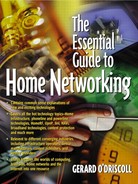CONSUMER REQUIREMENTS
The end users of a home network drive a different set of requirements than traditional enterprise network environments. These requirements include:
Ease of use, low complexity— Unlike an enterprise network, there is no network system administrator or IT department in the home. As a result, home networking must be easy to use and simple to install. A home network must be "invisible," providing seamless operation with little or no user intervention or maintenance.
Reliability— Home networks must be reliable. The network needs to resolve interference from other home networking devices as well as common household appliances, such as microwave ovens and cordless phones.
Scalability— As consumers begin to buy home networking products, scalability must be considered, even with their first purchase. Scalability results in a lower lifetime cost to the consumer. Buying a network device is not a point product purchase; it establishes the foundation for an entire home network. Consumers who make informed decisions will avoid purchasing technology that will soon be obsolete. A home network needs to maintain interoperability and accommodate future applications to protect the consumer's initial investment.
Standards compliance— Industry standards are crucial for enabling mainstream consumer adoption of home networking products.
No new wires— Consumers do not want to run hundreds of feet of cables around their home.
"My home is my castle"— The customer owns the data and decides who gets access to certain parts of this data.
